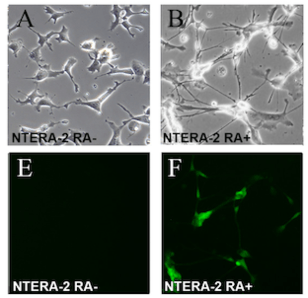NTERA-2
The NTERA-2 (also designated NTERA2/D1, NTERA2, or NT2) cell line is a clonally derived, pluripotent human embryonal carcinoma cell line.[1]

Characteristics
NTERA-2 cells exhibit biochemical and developmental properties similar to the cells of the early embryo, and can be used to study the early stages of human neurogenesis. The cells exhibit a high nucleo-cytoplasmic ratio, prominent nucleoli, and the expression of the glycolipid antigen SSEA-3. They also express nestin and vimentin, which are found in neuroepithelial precursor cells, as well as microtubule-associated proteins expressed in human neuroepithelium.[2] NTERA-2 cells also accumulate cytoplasmic glycogen.[3]
Differentiation
NTERA-2 cells differentiate when exposed to retinoic acid and lose expression of SSEA-3. Differentiation produces neurons via asymmetric cell division, and these cells form interconnected axon networks and express tetanus toxin receptors and neurofilament proteins.[4] By 10–14 days of exposure to retinoic acid, NTERA-2 cells begin to take on the morphological characteristics of neurons, such as rounded cell bodies and processes.[2] NTERA-2 cells can also produce a small number of oligodendrocyte-type cells, but they cannot differentiate into astrocytes.[5]
Research
Because of their similarity to human embryonic stem cells, NTERA-2 cells are used to study the dopaminergic differentiation of neuronal precursor cells.[6] They have also been proposed as an in vitro test system for developmental neurotoxicity.[7]
History
NTERA-2 cells were originally isolated from a lung metastasis from a 22-year-old male patient with primary embryonal carcinoma of the testis. The tumor was xenografted onto a mouse, and from this cells were cloned into the NTERA-2 cell line.[3]
References
- Lee VM, Andrews PW (1986). "Differentiation of NTERA-2 clonal human embryonal carcinoma cells into neurons involves the induction of all three neurofilament proteins". J Neurosci. 6 (2): 514–21. doi:10.1523/jneurosci.06-02-00514.1986. PMID 2419526.
- Pleasure SJ, Lee VM (1993). "NTera 2 cells: a human cell line which displays characteristics expected of a human committed neuronal progenitor cell". J Neurosci Res. 35 (6): 585–602. doi:10.1002/jnr.490350603. PMID 8411264.
- Andrews PW, Damjanov I, Simon D, Banting GS, Carlin C, Dracopoli NC, et al. (1984). "Pluripotent embryonal carcinoma clones derived from the human teratocarcinoma cell line Tera-2. Differentiation in vivo and in vitro". Lab Invest. 50 (2): 147–62. PMID 6694356.
- Andrews PW (1984). "Retinoic acid induces neuronal differentiation of a cloned human embryonal carcinoma cell line in vitro". Dev Biol. 103 (2): 285–93. doi:10.1016/0012-1606(84)90316-6. PMID 6144603.
- Marchal-Victorion S, Deleyrolle L, De Weille J, Saunier M, Dromard C, Sandillon F, et al. (2003). "The human NTERA2 neural cell line generates neurons on growth under neural stem cell conditions and exhibits characteristics of radial glial cells". Mol Cell Neurosci. 24 (1): 198–213. doi:10.1016/s1044-7431(03)00161-1. PMID 14550780.
- Schwartz CM, Spivak CE, Baker SC, McDaniel TK, Loring JF, Nguyen C, et al. (2005). "NTera2: a model system to study dopaminergic differentiation of human embryonic stem cells". Stem Cells Dev. 14 (5): 517–34. doi:10.1089/scd.2005.14.517. PMID 16305337.
- Stern M, Gierse A, Tan S, Bicker G (2014). "Human Ntera2 cells as a predictive in vitro test system for developmental neurotoxicity". Arch Toxicol. 88 (1): 127–36. doi:10.1007/s00204-013-1098-1. PMID 23917397.